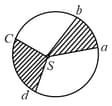H C Verma Solutions for Chapter: Gravitation, Exercise 2: OBJECTIVE I
H C Verma Physics Solutions for Exercise - H C Verma Solutions for Chapter: Gravitation, Exercise 2: OBJECTIVE I
Attempt the practice questions on Chapter 11: Gravitation, Exercise 2: OBJECTIVE I with hints and solutions to strengthen your understanding. CONCEPTS OF PHYSICS [VOLUME 1] solutions are prepared by Experienced Embibe Experts.
Questions from H C Verma Solutions for Chapter: Gravitation, Exercise 2: OBJECTIVE I with Hints & Solutions
The time period of an earth-satellite in a circular orbit is independent of
The magnitude of the gravitational potential energy of the moon-earth system is with zero potential energy at infinite separation. The kinetic energy of the moon with respect to the earth is . Which of the following is true?
The given figure shows the elliptical path of a planet about the sun. The two shaded parts have equal area. If and are the time taken by the planet to go from to and from to respectively. Then,

A person sitting in a chair in a satellite feels weightless because
A body is suspended from a spring balance kept in a satellite. The reading of the balance is , when the satellite goes in an orbit of radius and is , when it goes in an orbit of radius . Which of the following is correct?
How much kinetic energy is needed to project a body of mass from the Earth's surface to infinity?
A particle is kept at rest at a distance (Earth's radius) above the Earth's surface. The minimum speed with which it should be projected so that it does not return is
A satellite is orbiting the Earth close to its surface. A particle is to be projected from the satellite to just escape from the Earth. The escape speed from the Earth is . What is the particle speed with respect to the satellite?
